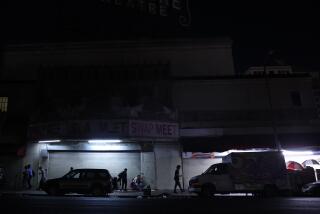Neighborhood’s Youths Work to Get the Dirt Out
- Share via
Mauricio Hernandez, just three months shy of his 14th birthday, quickened his pace across the alley in the Oakview section of Huntington Beach, hoping to catch a word with the young woman directing a group of teen-agers painting the alley’s graffiti-marred walls.
“You got a job for me? You got a job?” asked the anxious teen-ager, who hopes to be a doctor someday. Danielle Madison smiled at the familiar request.
“When’s your birthday, again?”
“May,” he whispered.
“In May, you got the job.”
What Hernandez and many other kids are jealously waiting for is a chance to sign up with LOGOS (Learning Organizing Growing Oakview Students), a federally funded program in which Oakview’s 14- to 19-year-olds can earn up to $140 a month cleaning up their neighborhood after school.
“It takes guts working alongside their peers,” says Madison, the program’s 23-year-old coordinator. “Other kids can tease them, but they are making the money.”
Earn the Minimum Wage
For the pledge of staying in school, Oakview students work 10 hours a week earning the minimum wage of $3.35 an hour. The program, which began last September, has been funded through the 1987 school year.
But Madison and other community leaders also hope Oakview’s youths learn a sense of responsibility.
“These kids learn the value of a job, neighborhood pride and what it means to punch a clock every day,” she said.
Since the program started, the after-school routines of 17 youths have been transformed. At 3:30, they throw down their books, hoist on a blue LOGOS T-shirt and red vest and fan out through the neighborhood with brooms and paintbrushes.
“When you’re our age, there’s no other job for you,” said True Yang, a 14-year-old Laotian boy whose hair and arms were sprinkled with paint on a recent afternoon after tackling an alley wall with graffiti on it. “Every day is fun now. Staying home watching TV--that was no good.”
“It’s boring at home,” chimed in Antonio Velez, who confided that he was worried about getting fired because he went to see a friend play basketball recently and neglected to call in to say he would miss work. “I used to just play around in the streets.”
City officials estimate that 5,000 people live in this self-contained, one-mile area, where Latino, Asian and white children fill the streets until dark and trucks playing Mexican jingles inch along, their owners selling fruits, vegetables and clothing.
According to the 1980 census, 50% of Oakview’s residents are minorities, compared to 10% citywide. It also has more than twice the citywide average of families living below the poverty line. Although Huntington Beach’s crime rate is relatively low, police records for 1985 show that Oakview, which is tucked behind the commercial thoroughfares of Warner Avenue and Beach Boulevard, had more than 2,000 reported incidents, third-highest among the city’s 140 policed areas.
Police and city officials have worried that the high incidence of vandalism and unemployment among many of the youths might make Oakview a ripe environment for street gangs.
Indeed, a group calling itself the Huntington South Side has left its mark--in graffiti--on many alley walls and garages.
“Our concern was that the younger kids, 9- to 11-year-olds, would look up to some of the older kids and follow their lead,” said Rich Barnard, an assistant city administrator.
Some Earn Rent Money
As a result, Barnard said the youth employment program, as well as a neighborhood improvement committee, were formed last year.
For some youths, LOGOS offers a chance to buy New Wave clothes. For others, such as Vietnamese brothers Dung and Em Dang, it’s a chance to help out with the rent.
“After school, I have nothing to do but watch cartoons,” said Dung Dang, who, along with his brother and father, fled from Vietnam in a boat. “So I decided to come out and work.”
Jose Luis Sosa, 14, finds the work--not to mention the attention--amusing.
“I like to work here,” said a grinning Sosa, while a neighborhood friend, Heidi Nance, chatted with him as he painted. “I like the streets to be clean.” The frustration of any cleaning job, of course, is that people will just make it dirty again.
“At first, little kids would throw trash on the ground after you swept up,” said Lisa Everhart, 15. “They would laugh at you and call you trash diggers. But now they pick it up.”
Even neighborhood cynics are coming around.
“Our neighborhood used to be all trashed out--a real dump,” said Jason Arrey, 13, who stopped his bicycle in the alley to half-heartedly watch the LOGOS team at work. “It seems a lot cleaner now.”
More to Read
Sign up for Essential California
The most important California stories and recommendations in your inbox every morning.
You may occasionally receive promotional content from the Los Angeles Times.










